ANDY WARHOL WANTED LOU REED TO BE HIS 'MICKEY MOUSE'
- Details
- Hits: 3160
Andy Warhol Wanted Lou Reed to Be His 'Mickey Mouse'
By Legs McNeil & Gillian McCain
August 28, 2016
From the column 'Please Kill Me'
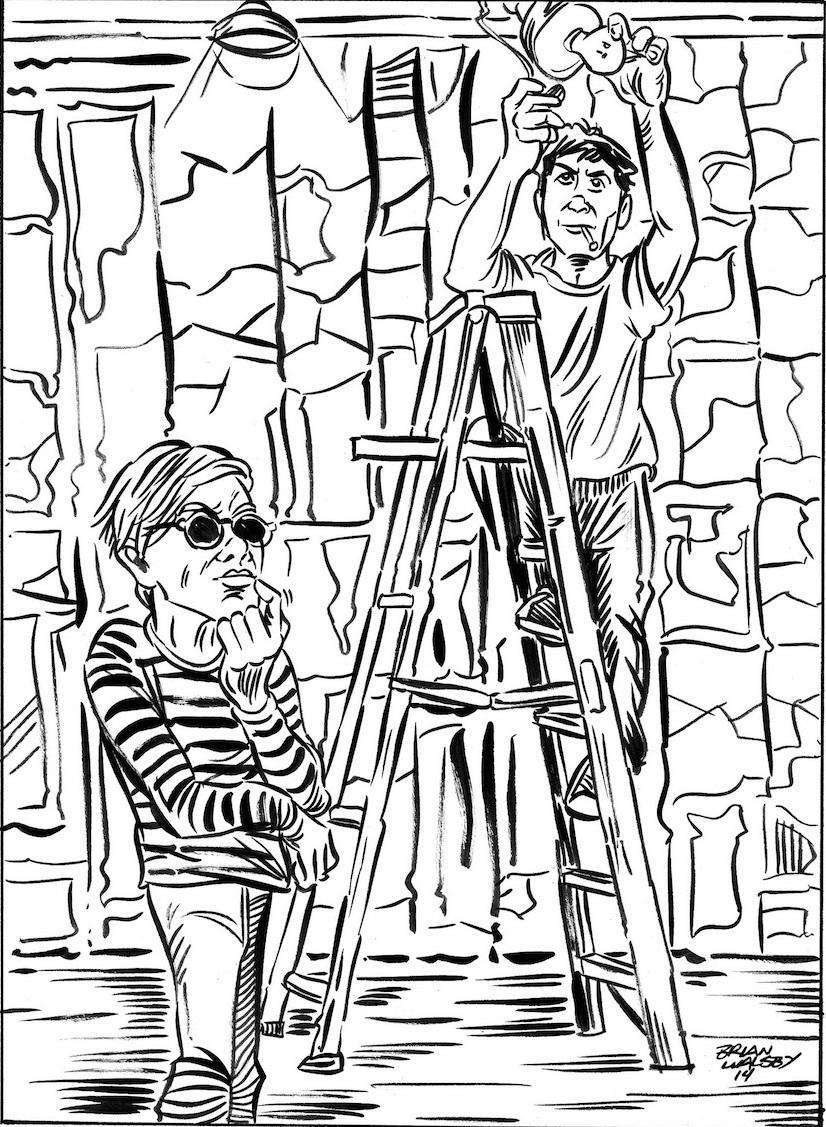
Art by Brian Wallsby
Billy Name was a magical guy who had a profound affect on Andy Warhol, and therefore, the entire culture. Billy was the one who decorated Warhol's original Factory in silver. Billy was a fantastic photographer who captured those beautiful 60s moments seen on a US Post Office commemorative stamp of Andy Warhol, as well as the first two Velvet Underground album covers.
Billy was many things to many people, but everyone considered him a friend.
Billy was so much fun that when Gillian McCain and I went to interview him in Poughkeepsie, New York in the mid 1990s, we had to go to Friendly's to have an ice cream–eating contest. Billy and Gillian both gobbled down a "Reese's Peanut Butter & Cookie Dough Hot Fudge Sundae," of which the results of the contest are still being tallied.
What was even better was that Lou Reed and John Cale's magnificent album, Songs for Drella had just been released, and we listened to it on Billy's awesome stereo while he provided hysterical commentary. Gillian and I both agree this was one of the best interviews we ever did.
Billy was a great interpreter of the insane, intelligent, drug-fueled, and fascinating world that was Andy Warhol's Factory. So much so, that Gillian and I included Billy in Please Kill Me: Voices from the Archives, our two-hour NPR radio documentary on the roots of punk rock that we produced to celebrate the 20th Anniversary of Please Kill Me. Voices from the Archive has been playing on NPR and college stations across the country all summer and fall, and Billy is one of the highlights of the show. He really was that special.
Billy Name (born William Linich Jr. on February 22, 1940) died on July 18, 2016 of natural causes, and we thought it would be a fitting tribute to let Billy tell his story in his own words.... Enjoy, it's a great one!
Andy Warhol came to one of the hair-cutting parties at my apartment, and he said, 'I just got this new space, this loft on 47th Street. Would you decorate it like you did with this apartment?' And that's how the Factory started.
Billy Name: I met Andy Warhol when I was working as a waiter at Serendipity, the hip dessert restaurant on the Upper East Side. Serendipity was this real cool place; Kim Novak used to come in all the time because she was being kept by the young Aga Kahn in his apartment up the street, ha, ha, ha! And Andy Warhol used to come in all the time, so we were on a first name basis, you know, "Hi Andy, how're you doing?"
There was a waiter at Serendipity named Ron, who used to go down to the bar the San Remo in the West Village on Saturday night after we got off, and one night, he invited me to go along. Greenwich Village was still very bohemian then; it was filled with jazz clubs and jazz musicians who were really into heavy heroin, and there was really great grass around. It was this whole new world of magic, mystery, and intuitive intelligence—that went beyond explaining about things—you know, smoke some grass and immediately get turned on to the chromatic waves of the music!
So the Village was like being in a Middle Eastern country, like Turkey, and it was so cool to be out of that middle-class, America-Eisenhower, new-refrigerator scene, you know?
The San Remo wasn't the literary crowd like at the White Horse—or the painterly crowd like at the Cedar Bar—it was sort of this hybrid of the arts. More like some existential, hip, cool place, but where you're not really doing anything, ha, ha, ha!
See, I got hooked up with some people through the crowd hanging out there, and that's how I met Nick Cernovich, and he and I got to be very good friends. He taught me how to do theatrical lighting, so I ended up being the lighting designer for the Judson Dance Theater Company. And another thing I would do is have salon hair-cutting parties at my apartment, because we never went to barbers, since we never had the money in the first place, ha, ha, ha! So during the time I was working with the dance companies people were also coming over to my house to get their hair trimmed.
This is very important—I had also covered my new apartment on East 5th Street with tinfoil, painted everything silver, and installed theater lights. It was like walking into a diamond, this great gem of a place. So I would be trimming somebody's hair, and there would be like 125 people there—all the dancers, artists, and musicians. It was just a cool place to hang out. Andy Warhol came to one of the hair-cutting parties at my apartment, and he said, "I just got this new space, this loft on 47th street. Would you decorate it like you did with this apartment?"
And that's how the Factory started.
When Andy moved into the Factory, it was this huge loft space. It had been a hat factory, I think. It had three arching ceilings, with columns in between, and it was in a state of disrepair. There were electrical outlets in the ceilings, but there were no fixtures. When I first went up there, Andy was painting by the front windows because there were no lights. So being experienced with theater lighting, I knew about electricity, so I went to a hardware store and bought all these fixtures and got the wiring down. I installed lights all the way down the rows of the arched ceilings with these long pull strings and then put spotlights in. Then I covered the whole place in tinfoil and painted everything silver.
In those days, in the avant-garde world, there was still the habit where older artists kept younger artists. The hetero artists always had a chick, and the gay guys always had a young guy with them. So when I first started being with Andy, it ended up that I was "his boy." He was keeping me, even to the point where I moved into the Factory. When he started to become famous, we were doing so much work and were so busy. I mean, we really loved each other, and we got along great, but I wasn't just this beautiful boy who wanted to be kept just for sex. So it only lasted until after I moved in. Then Andy got written up in Time , and all the attention that came with it just switched us over to a complete work relationship.
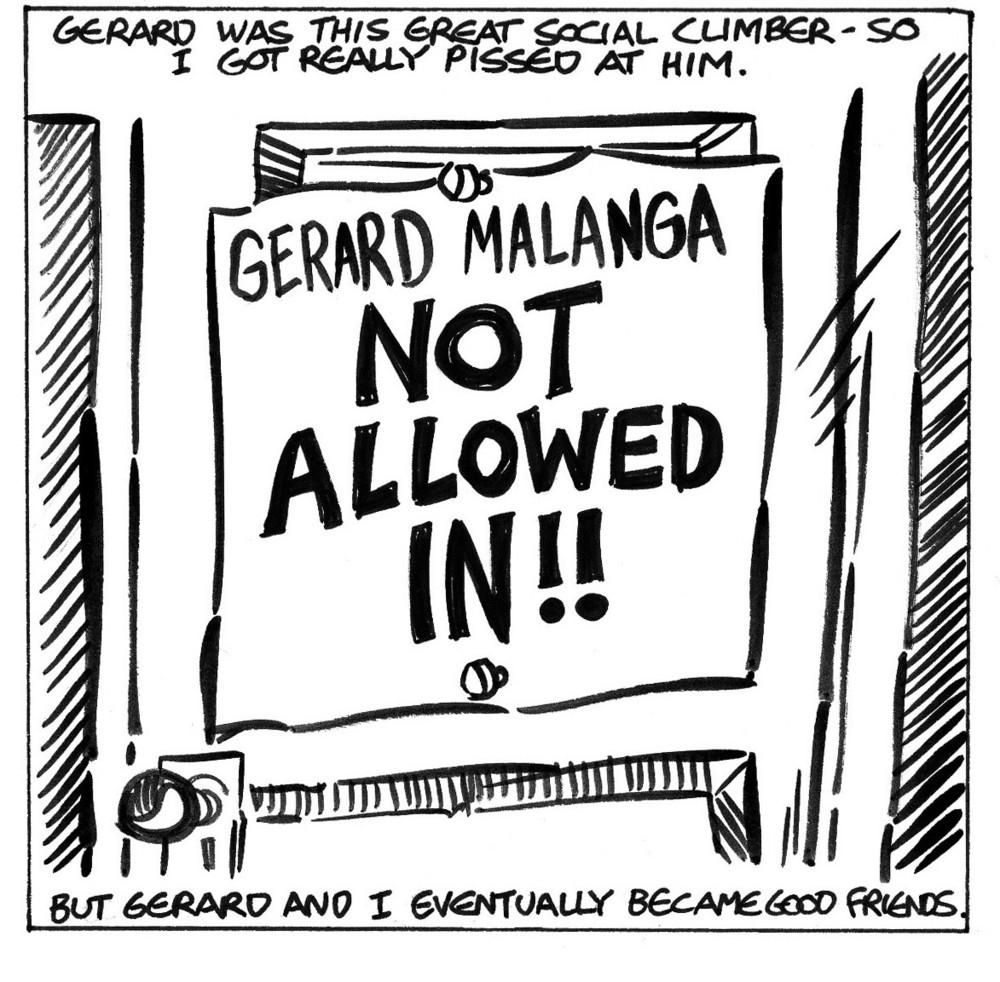 Andy would get to the Factory anywhere between 11 AM and 1 PM because he would first do things up at his house on Lexington Avenue. I had a whole setup at the Factory, with all these different areas—like the painting area, the filming area, and the music area. And then Andy hired Gerard Malanga to help him with his silkscreens, which Andy had been doing up at his house before we got the Factory. Gerard was a very cool guy and a with-it poet, but he was always this great social climber, you know?
Andy would get to the Factory anywhere between 11 AM and 1 PM because he would first do things up at his house on Lexington Avenue. I had a whole setup at the Factory, with all these different areas—like the painting area, the filming area, and the music area. And then Andy hired Gerard Malanga to help him with his silkscreens, which Andy had been doing up at his house before we got the Factory. Gerard was a very cool guy and a with-it poet, but he was always this great social climber, you know?
Gerard knew who to be seen with, and when, and how, and he was pretending to be kept by Andy because it was chic. So I got really pissed at him. When Andy wanted Gerard to come to the Factory and help with the silkscreens, I wouldn't let him in! If Andy wanted Gerard to work with him, he had to do it at his house. I was definitely very jealous, and not only jealous, but offended that Gerard had the audacity to pretend to "be kept" by Andy. I mean, that could've been real, if he wanted it to be real, but that was real for me, you know? It was like somebody ripping off your reality. So there were times when I would put up a sign in front of the elevator door that read, "Gerard Malanga Not Allowed In!"
Eventually, though, Gerard and I became good friends.
We actually had an opening party after Andy's first one-man show at the Stable Gallery, where he did the Brillo boxes. Afterward, the woman who owned the gallery, Eleanor Ward, paid for a reception party at the Factory. We even had Pinkerton guards with a guest list—you had to be on the guest list to get in. And there were hundreds of people there. It was THE event. So everybody came, and the Factory became immediately famous because it was such a stunning place.
I had met [actor and Warhol collaborator] Ondine back in the days when I was still doing the lighting design for dance companies. Around that time, I had a car accident where I crushed a vertebra in my neck, so there were a lot of times where I had a very low-energy level. I would just collapse on my floor after doing one of my lighting shows, so one day Ondine said, "Hey, try some of this stuff..."
It was amphetamine-crystal stuff, and all of a sudden I had energy and could just get up and start working and do everything. From that point on, I just took it all the time.
So I brought Ondine and Brigid Berlinand and all the people who were on amphetamines into the Factory. A lot of people nudged one another and said, "Oh Billy was really the one who was the cause of Andy getting shot" because I introduced all those wild elements into the Factory. And it's true. I introduced the "danger factor" into the Factory because when you walked in—not only were you knocked out by the beauty of it and the fact that there were artists just working all over the place—but there was a feeling of danger. You felt like you may not get out alive, ha, ha, ha!
I was a dangerous person.
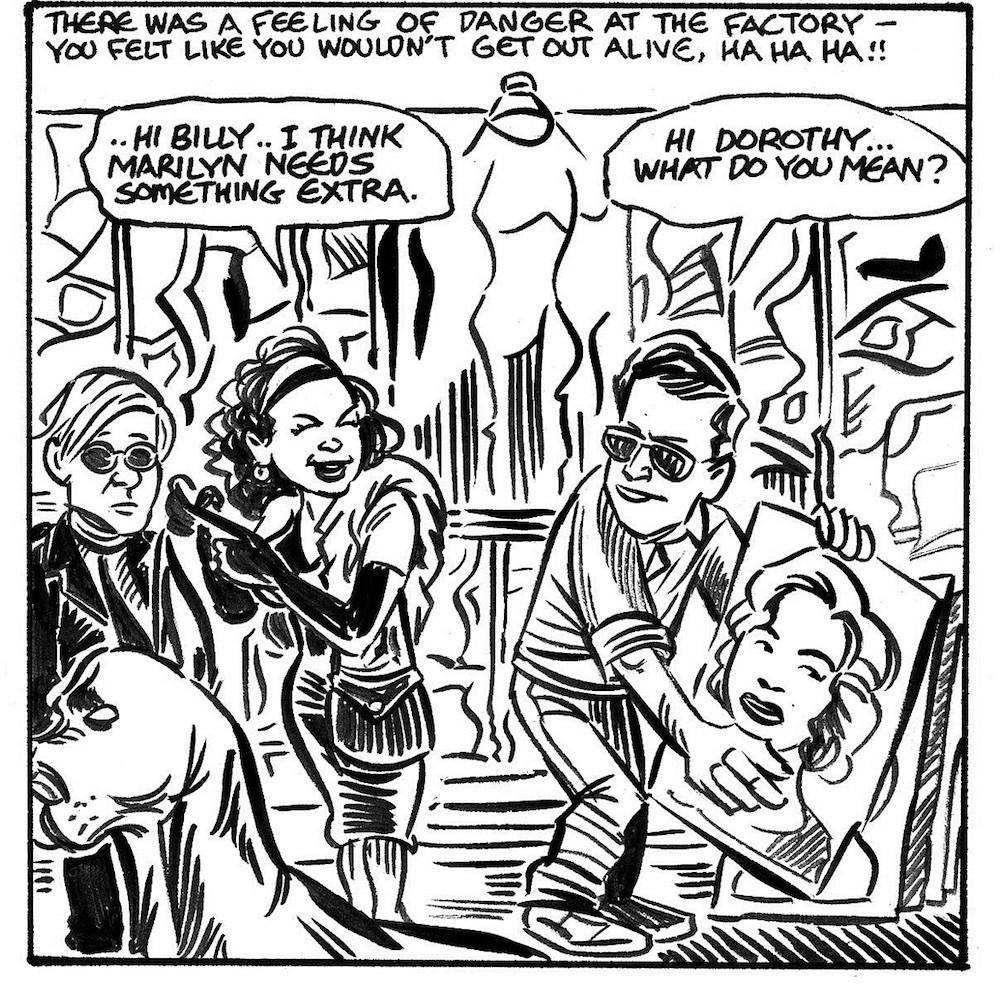
People have written about Andy as taking in these young people, using them up, and then dropping them or throwing them out... and then they kill themselves. But that is just wrong, you know?
I was dangerous in the sense that I would associate with people on the Lower East Side who were into the criminal element—like a woman named Dorothy Podber who was the one who shot Warhol's Marilyn Monroe paintings. Dorothy just walked in with her Great Dane, Yvonne, with her black gloves on and a black bag, and said, "Hi, Billy..."
Then she took her gloves off and opened her bag and took out the gun. There was a stack of ten Marilyn Monroe paintings leaning against the wall that we'd just finished. So she took the gun and shot Marilyn right through the forehead—and it went right through all them, ha, ha, ha!
And then she put the gun away in her bag and said, "Bye, Billy," and left.
It was like a performance piece.
After that, Andy asked me, "Please tell Dorothy not to come over anymore," because Andy knew that if he let people like Dorothy into the scene, then most of the people who were buying his work wouldn't come around anymore. They would've been traumatized, devastated, and wouldn't buy his artwork, ha, ha, ha!
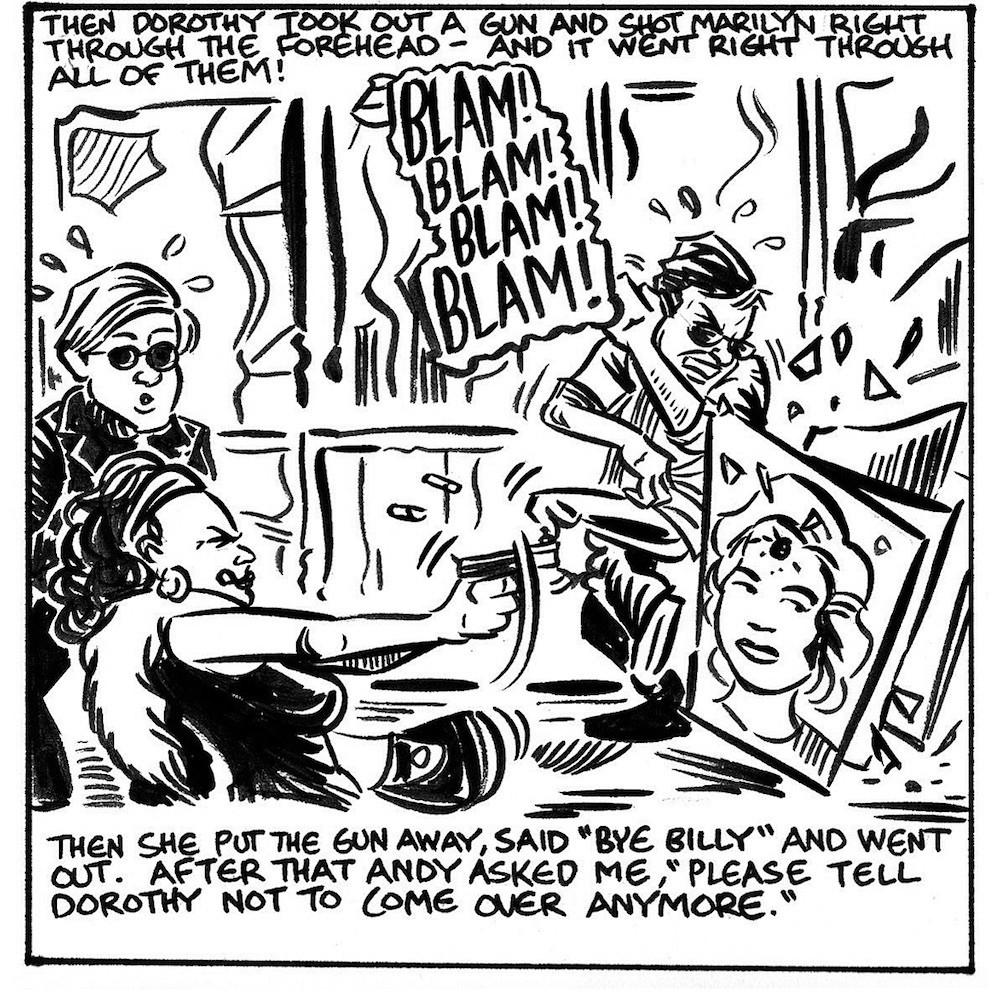 The only amphetamine Andy took was Obetrols, which he got from a doctor's prescription. They were supposed to be like diet pills because they were mellow, and they didn't over-excite him or over-aggravate him. Andy would have to work and have a congenial way about it, so the Obetrols worked for him. But Edie [Sedgwick] got into the amphetamine-crystal stuff with me, Ondine, and Bridget.
The only amphetamine Andy took was Obetrols, which he got from a doctor's prescription. They were supposed to be like diet pills because they were mellow, and they didn't over-excite him or over-aggravate him. Andy would have to work and have a congenial way about it, so the Obetrols worked for him. But Edie [Sedgwick] got into the amphetamine-crystal stuff with me, Ondine, and Bridget.
Edie had come from Boston with Chuck Wein, who was her director, mentor, and producer, and he really cut her the wrong way. Edie was young and beautiful and ripe, and should have been cut by a classic diamond cutter who knows how to cut stone. Chuck knew how to cut a stone, but also how to destroy it as well. Chuck was very difficult because he had his hand in the pie all the time. He was attempting to be her mentor, but she didn't need a mentor; she needed someone building her and presenting her and promoting her. But Chuck would get very picky with her and say bitchy things like, "Well, I thought you were so brilliant, how come you can't answer that question?"
If you watch Andy's film, Beauty No. 2, Chuck is off screen making comments to provoke Edie. They're like cutting, jibing remarks that she's supposed to respond to with genius comebacks, but it really ended up more destructive than a creative. Edie throws an ashtray at Chuck at the end of the movie. Chuck wanted her to be competitive with him, with those witty remarks, but she really needed somebody who would foster her along and move her to the next stage and cut her the right way.
But then, Ondine, I believe, turned Edie on to speed, and that really devastated any possibility of a career, because she would stay in her place and get ready for six hours, ha, ha, ha!Edie really got into amphetamines—you know, you can live in a dream world, assuming that things are just going to happen, because they should happen, instead of somebody making them happen. Also, Andy was working on several projects simultaneously, so we weren't only [focusing on] Edie. We weren't like Edie's managers or producers or agents. Edie was in Andy's films. She was one of Andy's stars, and he didn't give single individual attention to any of them. I mean, he was still working on his paintings; he was still trying to get somebody to invest so we could buy really great equipment. He was still arranging things. And Edie had to take what she could get.
She wasn't the single center of focus.
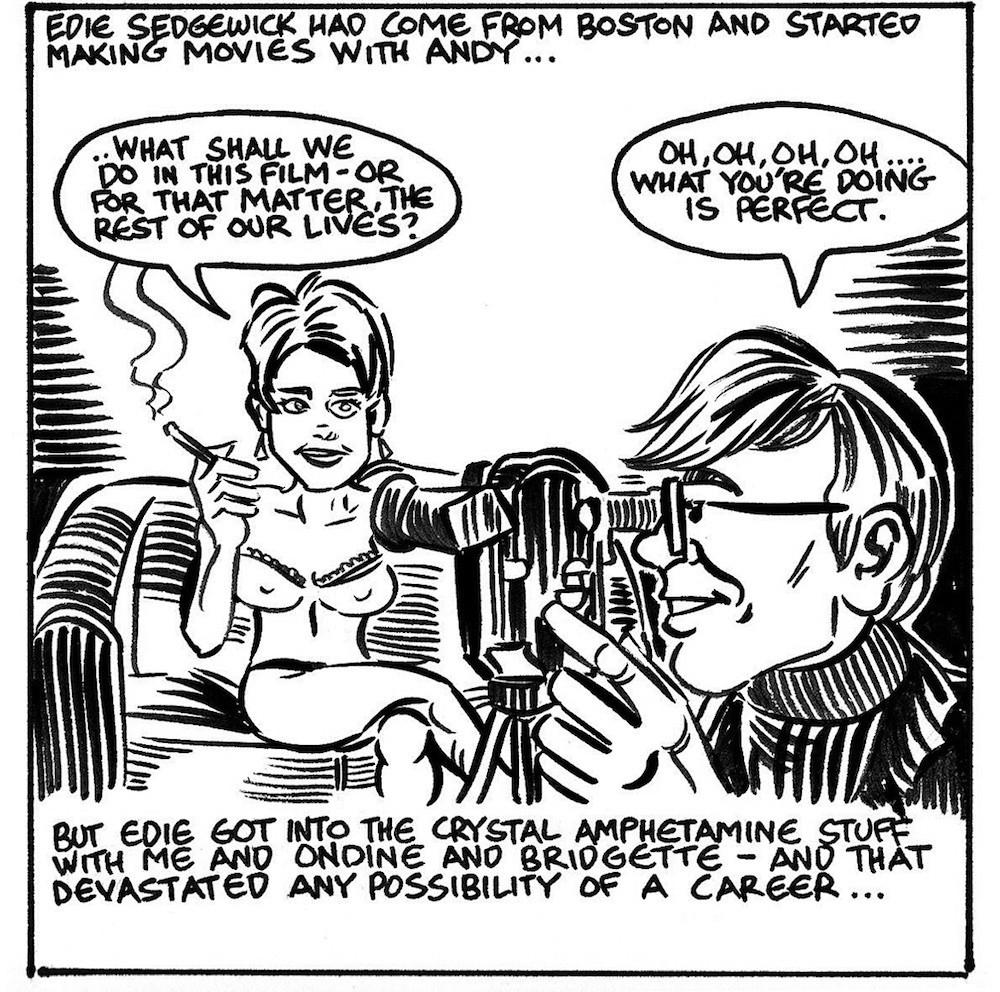
Edie wasn't happy with the way her career was progressing with Andy. I mean, she was so nonchalant about money in the first place, you know? She came to the Factory with her Mercedes, and she'd just park any place she felt like. Eventually, her car got towed away because she had so many summonses on it. So money wasn't the focus, she could still get money from her father, while Andy was scrambling to get money for our different projects. So Edie really dropped us. In the book, Edie: American Girl by Jean Stein and George Plimpton, they write sympathetic toward Edie and make Andy look like the villain, but it wasn't like that. People have written about Andy as taking in these young people, using them up, and then dropping them or throwing them out... and then they kill themselves. But that is just wrong, you know?
Edie dumped us. She walked out on us, and we didn't talk to her for a long time. We were really pissed when she went off with Bob Dylan and Albert Grossman, and just started working with other people. See, Dylan had come to the Factory because Andy was an artist who had gained international recognition, and it's always cool to meet other artists, you know, to see if it's somebody who's going to be a peer or a compatriot, who you can play with and hang around with or not. Andy was doing a series of screen tests for his films, and we wanted everybody to do one: Dylan, Nico, Dennis Hooper, Susan Sontag, Donovan—everyone famous that came up to the Factory. We'd just film 16mm black-and-white portraits of the person sitting there for a few minutes. So our purpose was to have Dylan come up and do a screen test, so he could be part of the series. That was enough for us.
But Dylan didn't talk at all when we filmed him. I don't think he liked us, ha, ha, ha!
 Supposedly Edie had an affair with Dylan, but it was really Dylan's pal, Bobby Neuwirth, that she fell for. Edie and Bobby Neuwirth were having this real torrid love affair, to the point that it ruined her career because they spent so much time in bed together! They couldn't disentangle themselves from each other because they were so hot for each other.
Supposedly Edie had an affair with Dylan, but it was really Dylan's pal, Bobby Neuwirth, that she fell for. Edie and Bobby Neuwirth were having this real torrid love affair, to the point that it ruined her career because they spent so much time in bed together! They couldn't disentangle themselves from each other because they were so hot for each other.
At that point, Edie was dissatisfied with what Andy was doing with her in his films and didn't like [Factory collaborator] Ron Tavel's scripts. So Andy said to her, "Well, you've gained notoriety and recognition now, so maybe it's the time if you want to go on to a bigger career, where you get yourself a manager or an agent who knows how to handle this, and get you into the Hollywood thing..."
Which is what he told all the people who worked for him: "You know, you're not really gonna go beyond this, and if you want the next step, you'll have to find the person who's gonna do it for you..."
So Edie played around with having Albert Grossman and Dylan manage her, but I guess that didn't work out. Paul Morrissey became her agent, but nothing happened with that. She wanted to move to the next level, but that didn't occur either. But we didn't live or die by what Edie did. She was just one of the people in our stable, one of the projects we were working on that didn't work out, or rather, that came to an end. So she was gone.
It wasn't any less glamorous at the Factory after Edie left, because once she left the Velvet Underground came in. See, the idea for the multimedia thing happened because we were going to do an Andy Warhol Film Festival at Jonas Mekas's Cinemateque, and we decided we didn't wanna just show all of Andy's films; we wanted to have people who were in the films be on the stage... while their films were projected on them. And then we decided we should do more lighting things. After that, we said, "Hey, wouldn't it be great if we added music, too? And then everyone could dance in front of their movies?"
That's where the idea of getting a music group came from.
Lou Reed was like a guy who grew up on your block who played in a band in your garage. He was a real cool guy from down the street who was just like you.
Let me backtrack. When I was still working with Nick Cernovich at the Judson Church, we became very good friends with La Monte Young, the minimalist composer, who was also the best drug connection in New York City. La Monte had chemist friends, so he got these big acid pills that were actually two colors, green on one side and yellow on the other. It was knock-out stuff where you would get really spaced out with the greatest wackos in New York City, ha, ha, ha!
La Monte would do these whole tortoise performances that would go on for days where he'd have people droning, which is the art of a holding a single tone for a long time. I would drone with La Monte's wife, Marian Zazeela, and people would be assigned to drone, and they would just come and go. John Cale was playing with La Monte then, plus Tony Conrad and Angus MacLise, who were the foundation of the original Velvet Underground. So I knew John, Angus, and Tony before the Factory scene, and before the Velvets were actually formed.
Rewind back to our idea to expand the multimedia thing to include music and dancing. That's when Gerard [Melanga] said he had seen this band that we should check out. I don't recall going to Cafe Bizarre to see the Velvets, but Andy and some others went. It turned out that we were going to do something with them. When the Velvets came up to the Factory, I recognized John Cale because I already knew him from La Monte Young's. So the Velvets fit right in because they were what Andy wanted—and it was like cementing the blocks right in place.
John Cale was cool. John is Mr. Cool. He's Mr. Welsh Ghost, who's into the mysticism of Wales—like coolness beyond life, beyond death. John's like the essence of coolness, so if you're a real cool person, you're automatically in tune with him. The most we would say to each other was, "Yeah," or "Uh huh," because you really didn't need to converse with John because he got it.
Lou Reed was like a guy who grew up on your block who played in a band in your garage. He was a real cool guy from down the street who was just like you. So Lou and I really got along as guys who, like, grew up together. It was almost like he was my brother. Lou was just so neat and charming and friendly and adorable. In a sense, he had a lot of what Edie Sedgwick had—that magic personality that was always poised and always right. He also had a little genius that came with these great ideas. But Lou was even more natural and more playful than Edie. I knew guys like Lou when I was a little kid, growing up in Poughkeepsie, but I never thought I woulda met them again. But I did with Lou. It was just like having a buddy again, you know?
[Velvet Underground drummer] Mo Tucker was very quiet, very rigid, and straight in her ways. She was a no-nonsense girl, but very easy to laugh. If something funny was going on, Mo was always willing to give you a little wisecrack—"Hey, what the fuck are you doing?" Because she knew what you were doing. Mo wasn't personable like Lou, or cool like John, but she had a knack for being attentive to everything around her and was able to give a funny little nudge to make you laugh.
[Guitarist] Sterling Morrison was an intellectual who seemed to bridge the art scene of John Cale with the rock 'n' roll world of Lou Reed.
Nico was too much really, let me tell you, and we were just so taken with her. So anything that we could think of for her to play a role in our scene was what we were going to do.
Then one day we were all at the Factory. Andy was at his table painting, I was doing something, Ondine was there, and Gerard comes waltzing in and says, "Hi, everybody, I have this record from my friend Nico, who I just met in Europe, I wanna play it for you, she's coming to New York..."
And Gerard had a 45 RPM single in his hand and put it on the turntable.
We all listened to it, saying, "Oh yeah, that's cool, that's cool...."
Then Nico came over from Europe, and we were all very taken by her. She was just this fascinating creature, who was totally NOT flamboyant or pretentious, but absolutely, magnetically controlling—and this Nordic beauty, too. And she didn't wear all the hippie flowers, she just wore these black pantsuits or white pantsuits, you know? Nico was too much really, let me tell you, and we were just so taken with her. So anything that we could think of for her to play a role in our scene was what we were going to do.
We wanted Nico to have a starring role in what we were doing, and since she was a chanteuse, Andy or Paul thought it would be great to have her sing with the Velvets. Of course, that was the total wrong thing you could say to them at that point in their development, because they were new and fresh on the scene, too, and now they're supposed to work this other person into their musical arrangement and set up?
But it just squeezed together and worked out... and was magic.
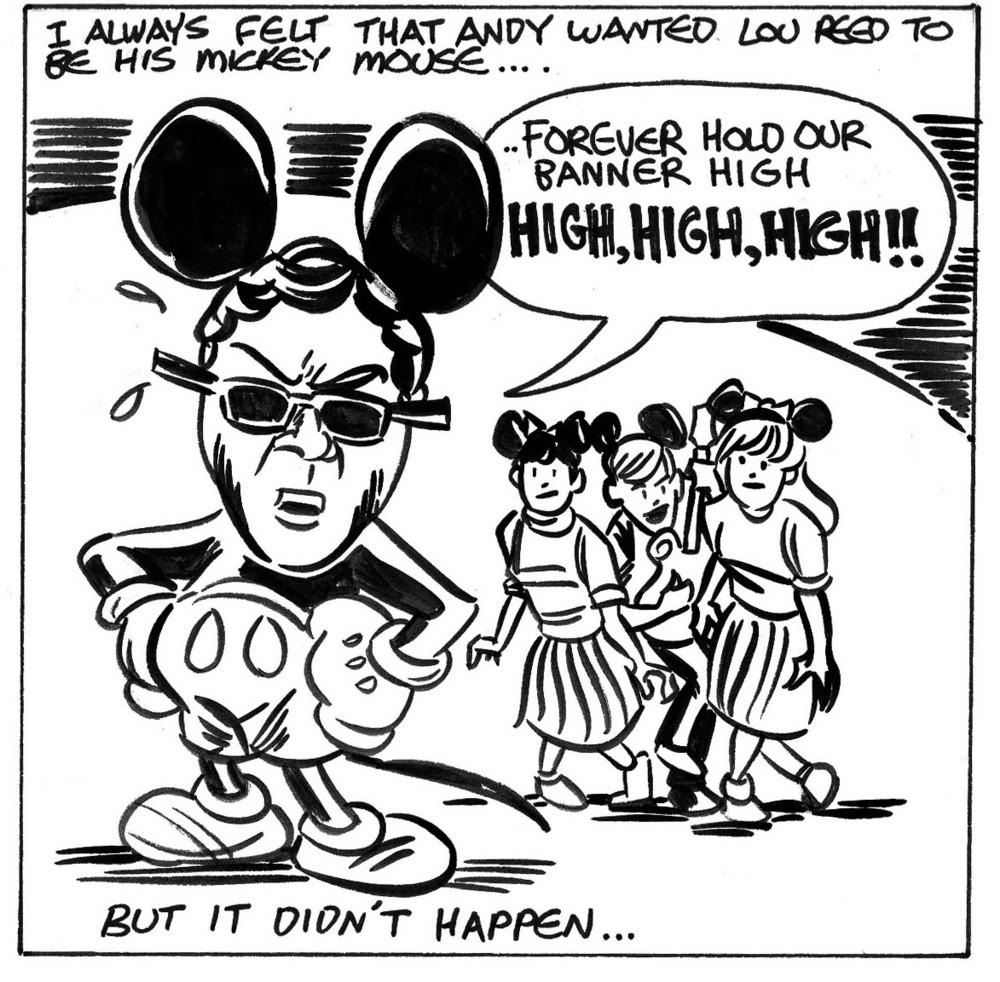
I always felt that Andy wanted Lou Reed to be his Mickey Mouse. Andy's studio was like the old Renaissance studios, and all the art went out under the name of the master, Andy Warhol, just like the Walt Disney studio. Walt Disney didn't invent Donald Duck; the people who worked for him created those Disney characters. And all this stuff we did at the Factory was under the aegis of Andy Warhol. So I always felt that Andy really wanted Lou to be his Mickey Mouse, this really big thing that everybody could latch on to because Lou was so adorable, and he was a rock star and a lead singer in a rock group. It would've been so right and so workable for Lou to have been Andy's Mickey Mouse, and do for Andy what Mickey did for Walt Disney.
But it didn't happen.
The single biggest factor that fucked up [ The Velvet Underground and Nico] when it came out and started to climb the charts was that Eric Emerson sued Verve, the Velvet's record label, because his image was on part of the collage on the back of the album cover. Eric wanted money for that, and nobody was willing to give it to him. So Verve pulled the record from all the stores, and it fell of the charts because it was no longer available. And it couldn't be saved.
Eric was a really beautiful person who hung out at Max's Kansas City and was in the stable of Factory performers. He was like one of your kids, or one of your brothers, a really nice guy, but he sued Verve, which was the wrong thing to do. We got really pissed at him because he really fucked up the album. It was like when you're lighting a fire and you get your spark, and the fire starts to build, and then Eric just pissed on the fire. So the magic was gone. That's what happened to the Velvets' first album. So Andy started thinking about other projects.
If that album had continued to go up the charts and was allowed to go as it had started to go, it might've changed the whole picture completely. The Velvets might have had a hit album, and Lou might've become Andy Warhol's Mickey Mouse.
So it wasn't Lou's fault that it didn't continue to work—it was Eric Emerson's.
And then Nico went off on her own. She still did club dates in Manhattan and around; she had these other guys playing with her. And John Cale made a tape for her, so she had music behind her to play at nightclubs. But she couldn't always get the tape machine to work, ha, ha, ha!
So with the second album, White Light/White Heat, the Velvets did it on their own, not with Andy. But they were still around the Factory, and I went over to Lou's loft and listened to the first pressing, and Lou came to the Factory to go through my negative file to choose something for the album cover. So the Velvets were still around, and we went to Max's Kansas City to see them play.
It was the end of an era—and then, just to punctuate it—Andy got shot.
At that time, the Factory building on 47th Street got sold, so we had to move, and Paul Morrissey found this space in this building at 33 Union Square. He liked it because it had all this great woodwork inside, and the front of the building had this great terra cotta front. It wasn't huge, but it was big enough. So we took that place.
See, at the first Factory, I had always been like the manager or the foreman, like the guy who ran it. But when we moved to the second Factory, Paul now moved into the front position as the space operator, and people now had to go through him rather than me. I was still photographing and doing darkroom work stuff, but the second Factory wasn't the same. So I was in the back most of the time.
And then we heard that John Cale left the Velvets.
John was really stronger than Lou once he made a decision. John felt the Velvets were too restricting for him—that the band really wasn't letting him develop his full talents anymore. So he left the band. He had started in classical music and wanted to experience a broader range of experience, and the Velvet Underground was too limited and too tight for him. So it was really John's doing. The whole thing of "Lou firing John" or that "Lou fired Andy" was cute stuff for storytelling. In actuality, John felt too limited and restricted, and he was much too talented. He just needed more room to work out all the other stuff he wanted to do.
It was the end of an era—and then, just to punctuate it—Andy got shot.
 I was in the dark room when I heard these bangs. I didn't know what the sound was. I was thinking, I can't figure out what's making that sound, but I know Fred [Hughes] is up front and Paul's up front, so whatever it is, I'm sure they'll be able to take care of it, so I'll just finish this up, then go out and see what's going on...
I was in the dark room when I heard these bangs. I didn't know what the sound was. I was thinking, I can't figure out what's making that sound, but I know Fred [Hughes] is up front and Paul's up front, so whatever it is, I'm sure they'll be able to take care of it, so I'll just finish this up, then go out and see what's going on...
So I opened that door and walked into the front part, and there was Andy on the floor, lying in a pool of blood.
I went right over to him. I was immediately down on my knees kneeling over him, I had my hand under him, I was just crying, and Andy said to me, "Don't, don't, don't make me laugh, it hurts too much..."
Then the ambulance came, and they put him in. I wasn't really paying attention to anybody else, so I didn't notice what Paul and Fred were doing.
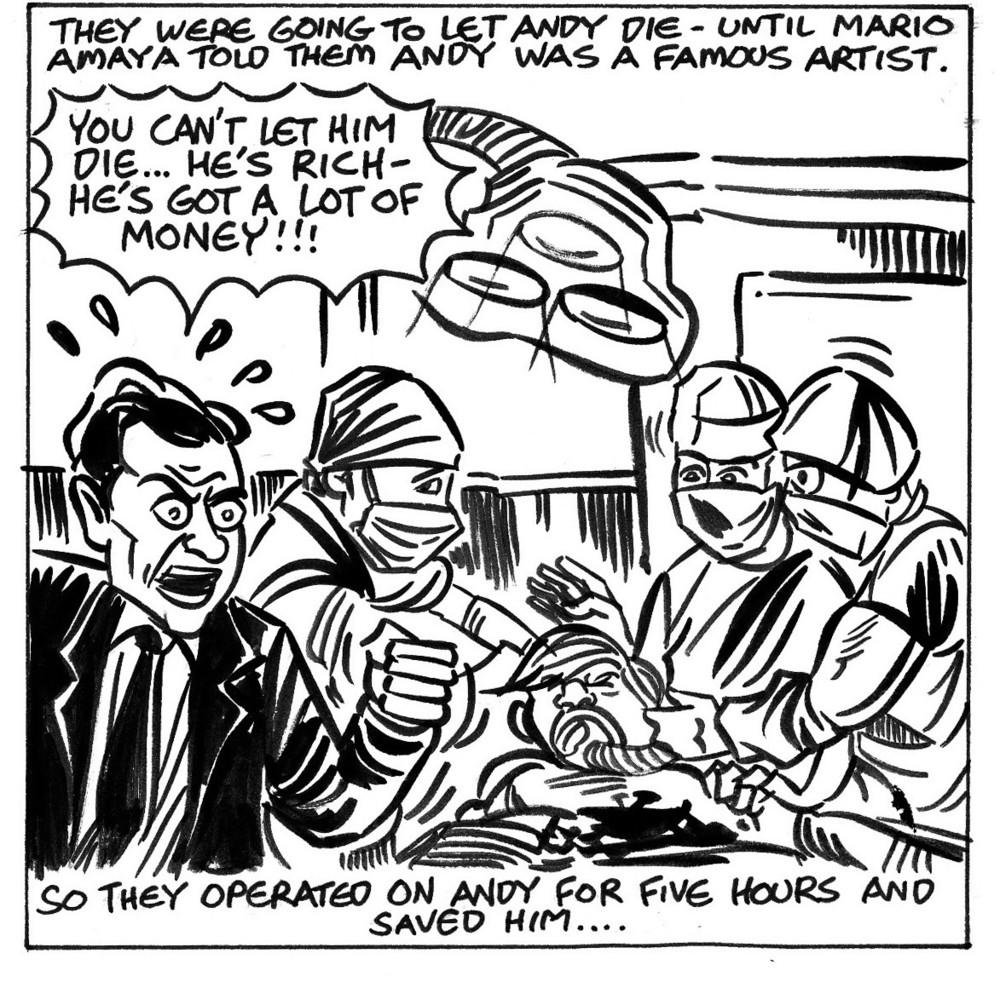
We all went to the hospital and were all just traumatized. They were going to let Andy die, until Mario Amaya—a gallery owner who'd also been shot by Valerie Solanas, but he was just grazed—told the doctors that Andy was a famous person. Mario was in the emergency room with Andy and heard the doctors over Andy's body, saying, "Oh this bullet has gone through so many organs. We can't do anything about it. There's nothing we can to do..."
Mario popped up and said, "You can't let him die. He's rich. He's gotta a lot of money, and he's a famous artist...."
So they operated on Andy for five hours and saved him. Actually Mario saved him by telling them Andy was a famous artist, because they were gonna let him die.
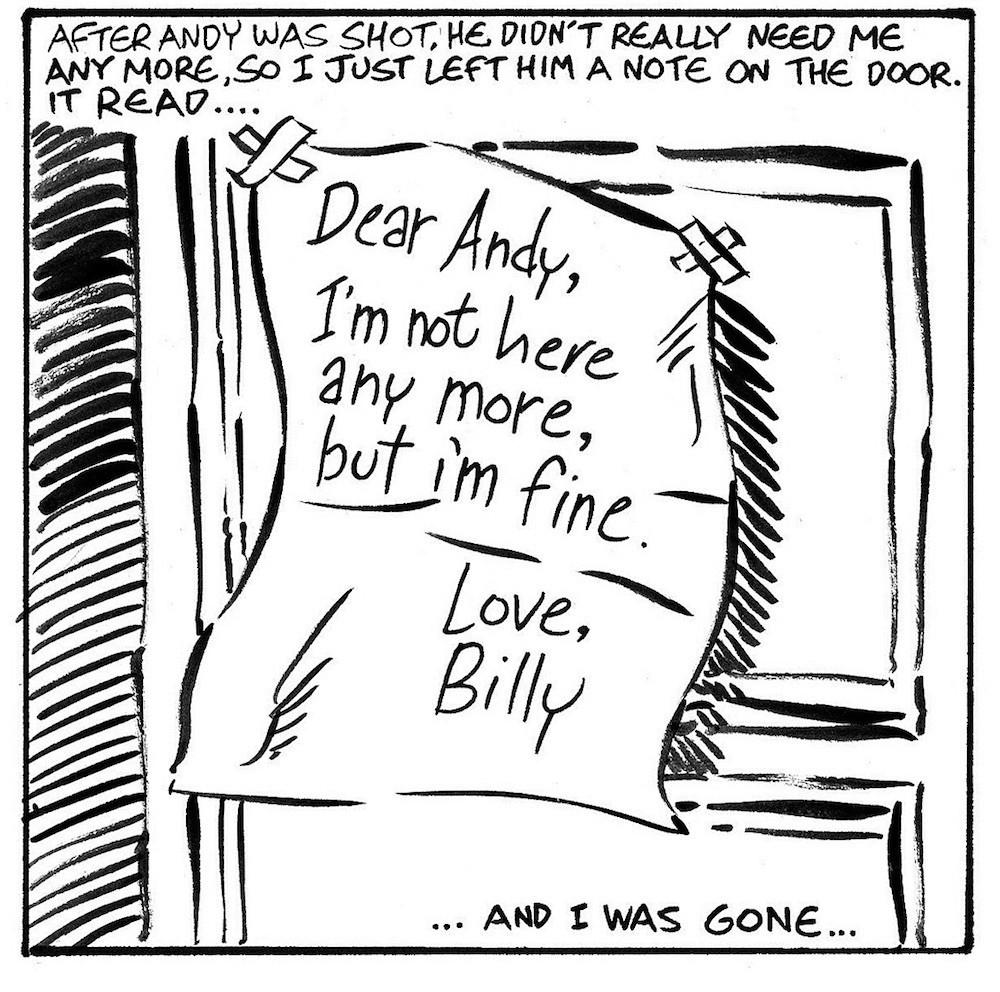
We had a contract with the Hudson Theatre to provide films for them, so when Andy was in the hospital, Paul took over as the director and started making all those Paul Morrissey movies, like Andy Warhol's Frankenstein and Andy Warhol's Dracula . Paul had a very strongly developed personality that was almost antithetical to the avant-garde, conceptual art, and to cool, hip, funny pop art. So once Paul started to get control, they were no longer art films. The art went out the window. The art disappeared.
Everybody really hated him for being like that, but he was so good at it. Paul was a nice-looking guy, very charming, and he was really good at his cutting style. So everyone said, "Well, it's really like crazy having a guy like that here in our scene, but he's probably the best of his style that we could find...."
Paul also had a really good sense of Andy and where Andy wanted to go, so they immediately linked and set about achieving Andy's goals. But Paul liked to trash everything, including Andy. Paul was like a male Katherine Hepburn, with that type of voice—very witty and cutting. He just had the right remark for every occasion. I mean, he'd just tear people to shreds—like the hippies and the whole California movement. So he was totally antithetical to all the other personalities who were pro-art.
After Andy was shot, the Factory became more business-oriented. I wasn't really into it, and I was feeling that I had lived in the Factory long enough. I had to get out and see what was going on in the rest of the world, you know? And if Andy needed anything, Paul Morrissey and Fred Hughes were both there. Andy didn't really need me anymore, so I just left a note on the door. It read, "Dear Andy, I'm not here any more, but I'm fine. Love, Billy."
And I was gone.
By Legs McNeil & Gillian McCain
Art by Brian Wallsby




